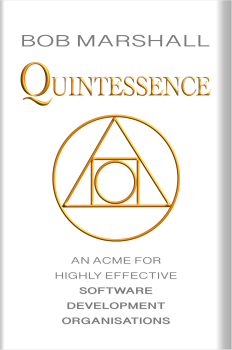Interactive Book: Quintessence – Chapter 18, Culture
Sidecar for Chapter 18 of “Quintessence” (Culture)
Selected ChatGPT Prompts
In the given chapter from “Quintessence,” the author discusses the importance of organisational culture and how it can be leveraged to achieve extreme effectiveness. Culture is defined as the collective programming of the mind that distinguishes one group from another. The chapter explores the concept of culture, its role in shaping an organisation’s view of itself and its environment, and the importance of aligning culture with purpose. To help readers dive deeper into the topic of culture using ChatGPT-4, here are ten heavyweight prompts:
- [Purpose] Define “Culture” in the context of organisational effectiveness.
[Prompt] What is organisational culture, and how does it contribute to an organisation’s effectiveness? - [Purpose] Understand the relationship between collective assumptions, beliefs, and culture.
[Prompt] How do collective assumptions and beliefs shape an organisation’s culture, and why is it important for an organisation to align its culture with its purpose? - [Purpose] Explore the role of individual memes in characterising organisational culture.
[Prompt] How do individual memes contribute to the characterisation of an organisation’s culture, and how does this relate to the concept of a collective mindset? - [Purpose] Delve into the impact of organisational culture on behaviour and system design.
[Prompt] How does organisational culture influence employee behaviour and the design of systems within the organisation? - [Purpose] Examine the role of culture in organisational change and adaptation.
[Prompt] Why is understanding and adapting an organisation’s culture crucial for successful change management and the achievement of its goals? - [Purpose] Investigate the concept of “culture change” and its limitations.
[Prompt] Why might focusing on “culture change” be less effective than addressing the underlying collective assumptions and beliefs in an organisation? - [Purpose] Analyse the concept of organisational psychotherapy.
[Prompt] How does organisational psychotherapy help organisations address challenges related to their collective mindset and culture? - [Purpose] Explore the importance of simultaneous shifts in culture.
[Prompt] Why is it important for an organisation to shift its collective mindset more or less simultaneously, and how can this be achieved? - [Purpose] Discuss the role of transitions in organisational change.
[Prompt] Define “transition” in the context of organisational change, and discuss its importance in shifting a collective mindset. - [Purpose] Examine the concept of memeplexes in relation to organisational culture.
[Prompt] Explain the concept of a memeplex and how it relates to collective mindsets in organisations.
These prompts are designed to help readers explore various aspects of organisational culture using ChatGPT-4. They can be used as-is or customised to fit specific needs or areas of interest. By engaging with these prompts, users can gain a deeper understanding of culture and its significance in organisations.
A Suggested Learning Path on the Topic of “Culture”
- Understanding Organisational Culture for Extreme Effectiveness.
[Prompt] Define organisational culture and explain its significance in achieving extreme effectiveness in quintessential organisations.
[Exercise] Reflect on your own organisation’s culture and list five characteristics that contribute to or hinder its effectiveness. - The Role of Assumptions and Beliefs in Organisational Culture.
[Prompt] Describe the role of collective assumptions and beliefs in shaping organisational culture and their connection to an organisation’s purpose.
[Exercise] Identify an aspect of your organisation’s purpose that may be misaligned with its collective assumptions or beliefs, and propose potential adjustments to improve alignment. - Organisational Psychotherapy: Understanding Culture through Memes.
[Prompt] Explain the concept of Organisational Psychotherapy and how it can help characterise an organisation’s culture through its individual memes.
[Exercise] Examine your organisation’s culture and identify three memes that significantly impact its collective mindset. - The System and Behaviour of an Organisation.
[Prompt] Discuss the relationship between the system within which an organisation operates and the behaviour of its members, according to John Seddon’s quote in the chapter.
[Exercise] Analyse your organisation’s system and suggest two changes that could lead to more desirable behaviours, supporting culture change. - Leadership and Culture Change.
[Prompt] Elaborate on the connection between organisational culture, leadership, and the effectiveness of culture change programmes.
[Exercise] Identify two instances where leadership within your organisation has either supported or hindered culture change and explain their impact on overall effectiveness
This learning path offers a structured approach to exploring the topic of Culture in the context of quintessential organisations.
Some Alternative Learning Paths
The number of potential learning paths related to the topic of Culture can be vast, depending on the depth and breadth of the subject matter. Here are 10 possible learning paths that could be useful in the context of Culture:
- Exploring the dimensions of national cultures and their impact on organisational culture.
- Understanding the role of leadership in shaping and maintaining organisational culture.
- Assessing the impact of organisational culture on employee engagement and satisfaction.
- Examining the relationship between organisational culture and performance.
- Investigating the role of communication in fostering a healthy organisational culture.
- Evaluating the influence of subcultures and diversity within organisations.
- Delving into the process of cultural integration during mergers and acquisitions.
- Studying the impact of technology and digital transformation on organisational culture.
- Exploring the role of ethics, values, and corporate social responsibility in shaping organisational culture.
- Investigating the process of cultural change management and overcoming resistance to change.
These learning paths can serve as a starting point for further exploration of the topic of Culture in the context of quintessential organisations or any organisation in general. Ask ChatGPT to elaborate on one or more of these paths, or suggest others.

